 I was curious as to what figurines were created as a candy dish and had no idea there were so many. I was able to locate 9 individual figures listed here but there may be more added as the information provides. This list begins with the lower number HUMs and increases as you scroll down. It is also, in some ways, an historical chronology of the plaques as they were created. Enjoy.
I was curious as to what figurines were created as a candy dish and had no idea there were so many. I was able to locate 9 individual figures listed here but there may be more added as the information provides. This list begins with the lower number HUMs and increases as you scroll down. It is also, in some ways, an historical chronology of the plaques as they were created. Enjoy.
This page was updated on 21 January 2021.
Hummels as Candy Boxes
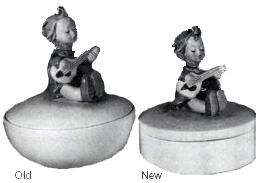
The candy box is considered here to be a small covered cylindrical box with a Hummel figurine on the top. There have been a number of design changes in the shape of the bowl from round to square over the years, as well as the manner in which the cover rests upon the bowl. They are numbered with the appropriate model number for the figure and preceded with the Roman numeral “III”. An example this would be III/53 for the candy box topped with HUM 53 “Joyful” as illustrated below with the old round bowl and the newer squared off bowl.
The MEL Pieces
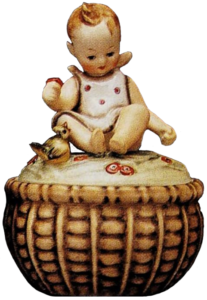 There are at least seven of a possible twenty-four pieces known to exist today. Instead of having an inscribed HUM, they show an earlier inscribed MEL along with the mold number. Factory records have the modeling of MEL 4 and MEL 5 as both candy dishes, one with a boy on top and the other with a girl. Two others have been identified as MEL 6 Child in Bed Candy Dish and MEL 7 Tiny Child Angel (sitting on the lid of a candy dish). MEL 7 was released around 1947 and was adapted from an unknown drawing by Sister Hummel. This small figurine must certainly be categorized as unique at this time with a value in the very high hundreds.
There are at least seven of a possible twenty-four pieces known to exist today. Instead of having an inscribed HUM, they show an earlier inscribed MEL along with the mold number. Factory records have the modeling of MEL 4 and MEL 5 as both candy dishes, one with a boy on top and the other with a girl. Two others have been identified as MEL 6 Child in Bed Candy Dish and MEL 7 Tiny Child Angel (sitting on the lid of a candy dish). MEL 7 was released around 1947 and was adapted from an unknown drawing by Sister Hummel. This small figurine must certainly be categorized as unique at this time with a value in the very high hundreds.
HUM III/53 – Joyful
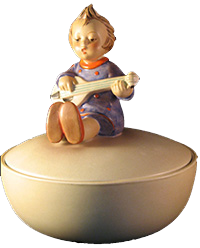 This figure has also been known as “Banjo Betty”. This candy box, when first designed and released in 1936, was rounded in the form of a semisphere or bowl and the cover was slightly crowned and designed to fit inside and flush with the top edges of the bowl. The model number is found on the underside of the lid while the “M.I. Hummel” signature is found on topside of the lid directly behind the figure. In 1964, the box was redesigned, along with other candy boxes, in a cylindrical shape with vertical sides and a flanged top which was flush with the sides. The older design included TMK-1, TMK-2 and TMK-3. It is possible there was some overlapping of the marks when the new design was being introduced.
This figure has also been known as “Banjo Betty”. This candy box, when first designed and released in 1936, was rounded in the form of a semisphere or bowl and the cover was slightly crowned and designed to fit inside and flush with the top edges of the bowl. The model number is found on the underside of the lid while the “M.I. Hummel” signature is found on topside of the lid directly behind the figure. In 1964, the box was redesigned, along with other candy boxes, in a cylindrical shape with vertical sides and a flanged top which was flush with the sides. The older design included TMK-1, TMK-2 and TMK-3. It is possible there was some overlapping of the marks when the new design was being introduced.
HUM III/57 – Chick Girl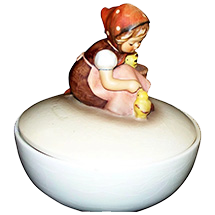
The bowl style was first produced in 1936 while the jar style was first produced and sold in 1964. It is sometimes found with the incised number III 57/0 on the bowl style pieces. The model number is found on the underside of the lid while the “M.I. Hummel” signature is located on the topside of the lid directly behind the figure. Chick Girl candy box was “temporarily withdrawn” (TW) from production on 31 December 1989. Overall size of this figure and box is 5¼ inches or 6¼ inches depending upon the source of information. Differences probably due to a design change in the type of bowl and the lid used. Newer lids also show green grass painted around the figures while the older models do not show this.
HUM III/58 – Playmates
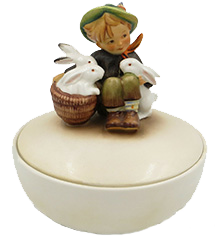
The bowl style was first produced in 1936 while the jar style was first produced and sold in 1964. It is sometimes found with the incised number III 58/0 on the bowl style pieces. The model number is found on the underside of the lid while the “M.I. Hummel” signature is located on the topside of the lid directly behind the figure. The Playmates candy box was “temporarily withdrawn” (TW) from production on 31 December 1989. Overall size of this figure and box is 5 ¼ “ or 6 ¼ “ depending upon the source of information. Differences probably due to a design change in the type of bowl and the lid used. As of this date, there has been only one report of this candy box with the Crown mark, TMK-1. On the newer style box, the far right rabbit’s ears follow the positioning of the ones in 58/0. Both shapes of boxes have been used on this candy box. The curved sided, bowl-shaped box usually has TMK-1, TMK-2 and TMK-3. The straight-sided cylinder design may have TMK-3 through TMK-6. In 1996, a new “M.I. Hummel” collector box was issued through The Danbury Mint in Norwalk, CT and sold by mail order only. It is the same as the jar style box with the only difference being that the color graphics have been added.
HUM III/63 – Singing Lesson
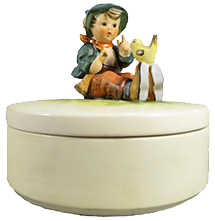 The bowl style was first produced in 1937 while the jar style was first produced and sold in 1964. The old name of this is “Duet” box. The model number is found on the underside of the lid while the “M.I. Hummel” signature is located on the topside of the lid directly behind the figure. The Singing Lesson candy box was “temporarily withdrawn” (TW) from production on 31 December 1989. Overall size of this figure and box is 5¼ inches or 6¼ inches depending upon the source of information. Differences probably due to a design change in the type of bowl and the lid used. The positioning of the arms and head may vary in the assembly of this figurine.
The bowl style was first produced in 1937 while the jar style was first produced and sold in 1964. The old name of this is “Duet” box. The model number is found on the underside of the lid while the “M.I. Hummel” signature is located on the topside of the lid directly behind the figure. The Singing Lesson candy box was “temporarily withdrawn” (TW) from production on 31 December 1989. Overall size of this figure and box is 5¼ inches or 6¼ inches depending upon the source of information. Differences probably due to a design change in the type of bowl and the lid used. The positioning of the arms and head may vary in the assembly of this figurine.
HUM III/69 – Happy Pastime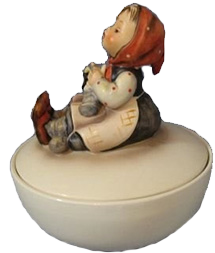
The bowl style was first produced in 1937 while the jar style was first produced and sold in 1964. The model number is found on the underside of the lid while the “M.I. Hummel” signature is located on the topside of the lid directly behind the figure. The Happy Pastime candy box was “temporarily withdrawn” (TW) from production on 31 December 1989. One interesting variation of this candy box, found with a pastel green rim on both the bottom and the top of the old-style box, commands a 25% premium over the plainer version. The original drawing was the same one that was used for the 1978 Annual Plate, HUM 271 and the figurine HUM 69.
HUM III/110 – Let’s Sing
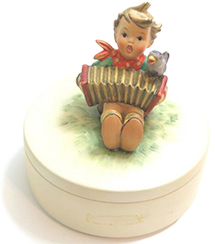 The bowl style was first produced in 1938 while the jar style was first produced and sold in 1964. The model number is found on the underside of the lid while the “M.I. Hummel” signature is located on the topside of the lid directly behind the figure. The Let’s Sing candy box was “temporarily withdrawn” (TW) from production on 31 December 1989. Overall size of this figure and box is 5¼ inches or 6¼ inches depending upon the design type of the lid. Newer models have a newly designed lid and these are a bit larger.
The bowl style was first produced in 1938 while the jar style was first produced and sold in 1964. The model number is found on the underside of the lid while the “M.I. Hummel” signature is located on the topside of the lid directly behind the figure. The Let’s Sing candy box was “temporarily withdrawn” (TW) from production on 31 December 1989. Overall size of this figure and box is 5¼ inches or 6¼ inches depending upon the design type of the lid. Newer models have a newly designed lid and these are a bit larger.
HUM III/221 – Happy Pastime
Closed Number (CN)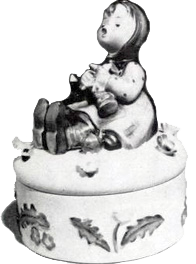
This candy jar was made as a sample only and was never produced for sale. First modeled by master sculptor Arthur Möeller in 1952. According to Robert Miller’s Authorized Supplement to HUMMEL, this number was previously listed as “Unknown,” as factory records indicated it was a Closed Number (CN). HUM 221 was planned at one time to be a Glamorized version of the present Candy Box, HUM III/69. The main difference was the addition of flowers and blossoms on the top and sides of the box which would have been very vulnerable to damage. The bird was also positioned in front of the girl and her kerchief was without polka dots. It is now known that this is a pre-production sample never released. No know examples are known outside the company archives. This additional information is given in case you are the fortunate collector to have the only one known other than the factory sample and have it insured for a few thousand dollars.
HUM III/435 – Delicious
Possible Future Edition (PFE)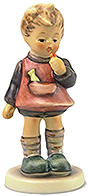 This is of a child standing, about to eat a red piece of candy held in their left hand. This may have had a very similar figurine that is now produced as the four-inch HUM 435 Delicious shown here.
This is of a child standing, about to eat a red piece of candy held in their left hand. This may have had a very similar figurine that is now produced as the four-inch HUM 435 Delicious shown here.
References
Hotchkiss, J. F., & Cassidy, C. (1981). Hummel art II. Des Moines, Iowa: Wallace-Homestead.
Luckey, C. F. (1997). Luckey’s Hummel figurines & plates: Identification and value guide. Iola, WI: Krause Publications.
Miller, R. L. (2003). The no. 1 price guide to M.I. Hummel: Figurines, plates, more. Cumberland, MD: Portfolio Press.